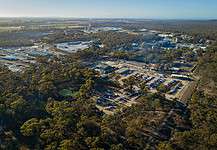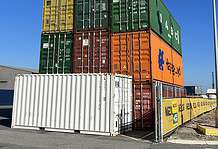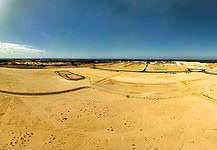All images: Kirkland Lake Gold
BY: JESSICA CUMMINS
KIRKLAND Lake Gold’s Fosterville mine reported more than 140,000 ounces of gold production for the first half of 2018, representing a 33 per cent year on year increase in output. The Australian Mining Review speaks with Kirkland Lake Gold Australia vice president Ian Holland about the company’s exploration plans and outlook for the remaining of the year.
Q. Since acquiring Fosterville, Kirkland Lake has managed to boost production by 70 per cent and increase the projects reserves by 210 per cent rising to 1.03 million ounces. Can you explain the key drivers behind this success??
The growth in both production and reserves at Fosterville has been directly attributable to the substantial lift in grade that has been seen over the last couple of years. Full year mill grade averaged 7.6 g/t Au in 2016, rising to 15.8 g/t Au in 2017 and rising further to 18.7 g/t Au in H1 2018. Accompanying this has been a prodigious lift in reserve grade from 9.8 g/t Au (0.49 million ounces) in December 2016 to 17.9 g/t Au (1.03 million ounces) in June 2017 to 23.1 g/t Au (1.70 million ounces) in December 2017 which is the most recent update. This has been the result of an observed change in the style of mineralisation at depth with the increasing presence of high-grade mineralisation consisting of quartz with visible gold occurring within and typically enveloped by moderate-grade sulphide mineralisation. This has been rapidly unlocked by the aggressive exploration program that Kirkland Lake have implemented – there are currently 12 drill rigs employed at Fosterville on surface and underground.
Q. You have worked at Fosterville for some time – previously as general manager of the mine. What was it like to be acknowledged at the Diggers and Dealers conference this year?
It was very rewarding, particularly on behalf of the long-standing team at Fosterville who have been through significant challenges and much leaner times. There is a low turnover at the operation so many of the team have been there essentially from inception and it is a tribute to them. Important to stay humble though, we all have to appreciate the cyclical nature of the industry we work in.
Q. What feedback did you receive from industry during the conference?
I think it was really well-received. With Fosterville located in Victoria and being owned by Canadian-based companies since 2008, it’s fair to say that we have been under the radar in terms of the Australian industry until recent times. That’s certainly changed and the industry is taking a closer look at how that’s occurred and what other opportunities that may highlight.
Q. How has Fosterville opened new opportunities for other mining explorers in the region?
I think the recent success at Fosterville has certainly highlighted the potential that remains in Victoria for high-grade gold discoveries. The Geological Survey of Victoria have done some excellent work over recent years highlighting the potential for further discoveries including under cover in the northern part of the State. With the high-grade discoveries at Fosterville, the market can now see this in action and this allows for junior explorers to more readily raise funds and pursue targets.
Q. Tell us about your exploration campaign underway at Fosterville?
The majority of the work to date has been on the existing mining licence at Fosterville which is ~17km2. We also hold a very large-scale enveloping set of exploration licences (~1900km2) which are known to host multiple structures parallel to the Fosterville line where there are either historic resources and/or historic workings. We really see district-scale potential and have significantly increased our investment in regional exploration with a combination of soil sampling, gravity surveys, 3-D seismic surveys and drilling either currently in progress or planned for the near future.
Q. Kirkland chief executive and president Tony Makuch recently mentioned the company may not have stumbled upon the “real gold deposit” yet. How long do you think this will take?
The rate of change over the last couple of years has been so significant that it is difficult to predict just how large this deposit could be. With the scale of investment going into exploration (as mentioned – 12 drill rigs currently in action), the information flow is massive and this continually updates our understanding of the future potential. It’s certainly fair to say that we think Fosterville will be in operation for many, many years to come!
Q. What is Fosterville focusing on for the remaining of the year?
Firstly, Fosterville is focused upon finishing the year strongly in terms of production. Full-year guidance was recently revised upwards to between 275,000 – 300,000 ounces of gold produced which would comfortably eclipse the previous annual record of ~264,000 ounces achieved in 2017. Secondly, in terms of the future there is the continued exploration as described above as well as a number of major projects which are key to the next phase of growth. These major projects include a ventilation upgrade, pastefill plant and mine water treatment plant which are all expected to be completed in 2019 and provide the platform for the projected increase in production profile at Fosterville to +400,000 ounces per annum by 2020. Underpinning all of this is our continued deep commitment to be a safe and sustainable operation.
Q. How was Kirkland’s exploration program at Cosmos going?
Since suspending production at Cosmo in June 2017, we have aggressively explored to understand the scale potential of the overall system. This resulted in the discovery of the Lantern deposit which was first announced in March 2017 and sits adjacent to the Cosmo deposit. We’ve continued our drilling program with four drill rigs currently in operation underground. More recently, we have also re-commenced underground development to serve both as improved drilling platforms and to expose the Lantern mineralisation to improve our understanding of the geological controls and continuity.
In addition, we are undertaking significant surface drilling at Union Reefs which sits 60km to the SE of Cosmo and adjacent to our processing plant. This drilling has been successful at highlighting the scale potential of this system with high-grade intercepts drilled at depths up to 1,000 metres below surface.
The combination of these two centres both showing significant scale potential, an adjacent processing plant and significant further exploration potential has us excited about what the future could hold for Kirkland Lake Gold in the Northern Territory.
Q. When is Cosmos expected to restart operations?
Subject to internal and regulatory approval, we are aiming at restarting production as soon as possible.
Q. Kirkland has also acquired an 18 per cent stake in Novo Resources along with other gold focused investments in the Pilbara. What are your plans for the area?
Yes, we hold strategic stakes in both Novo Resources and De Grey Mining which have gold-focused exploration tenure in the Pilbara. The first point to make here is that we recognise the relatively early-stage nature of the search for conglomerate-hosted gold mineralisation in the area. When we consider the province as a whole, we see very significant amounts of gold being found in multiple locations hundreds of kilometres apart which highlight to us the potential scale. We have had our own people on the ground for significant periods of time and we can see the gains being made in terms of understanding controls and distribution. The full potential will take time and investment to unlock but we continue see the potential for future low-cost production which we would want to a part of.
Q. Is there anything else that you would like to add?
I really want to emphasise the importance we place in investment in exploration. Our two high-grade flagship operations (Fosterville in Victoria and Macassa in Ontario) were both transformed by discoveries made well after the operations had commenced. This value-creation through the drill bit is in our DNA and is reflected in our industry-leading commitment to exploration. This continues at all of our current operations and projects and drives our evaluation of other opportunities.






















































